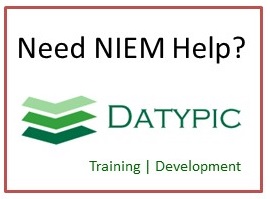gml:Face
gml:Face represents the 2-dimensional topology primitive. The topological boundary of a face (gml:directedEdge) consists of a sequence of directed edges. If provided, the aggregationType attribute shall have the value "sequence". The optional coboundary of a face (gml:directedTopoSolid) is a pair of directed solids which are bounded by this face. A positively directed solid corresponds to a solid which lies in the direction of the negatively directed normal to the face in any geometric realisation. A face may optionally be realised by a 2-dimensional geometric primitive (gml:surfaceProperty).
Element information
Namespace: http://www.opengis.net/gml/3.2
Schema document: external/ogc/gml/3.2.1/topology.xsd
Type: gml:FaceType
Properties: Global, Qualified
Content
- Sequence [1..1]
- gml:metaDataProperty [0..*] deprecated
- gml:description [0..1] The value of this property is a text description of the object. gml:description uses gml:StringOrRefType as its content model, so it may contain a simple text string content, or carry a reference to an external description. The use of gml:description to reference an external description has been deprecated and replaced by the gml:descriptionReference property.
- gml:descriptionReference [0..1] The value of this property is a remote text description of the object. The xlink:href attribute of the gml:descriptionReference property references the external description.
- gml:identifier [0..1] Often, a special identifier is assigned to an object by the maintaining authority with the intention that it is used in references to the object For such cases, the codeSpace shall be provided. That identifier is usually unique either globally or within an application domain. gml:identifier is a pre-defined property for such identifiers.
- gml:name [0..*] The gml:name property provides a label or identifier for the object, commonly a descriptive name. An object may have several names, typically assigned by different authorities. gml:name uses the gml:CodeType content model. The authority for a name is indicated by the value of its (optional) codeSpace attribute. The name may or may not be unique, as determined by the rules of the organization responsible for the codeSpace. In common usage there will be one name per authority, so a processing application may select the name from its preferred codeSpace.
- gml:isolated [0..*]
- gml:directedEdge [1..*] A gml:directedEdge property element describes the boundary of topology faces, the coBoundary of topology nodes and is used in the support of topological line features via the gml:TopoCurve expression, see below. The orientation attribute of type gml:SignType expresses the sense in which the included edge is used, i.e. forward or reverse.
- gml:directedTopoSolid [0..2] The gml:directedSolid property element describes the coBoundary of topology faces and is used in the support of volume features via the gml:TopoVolume expression, see below. The orientation attribute of type gml:SignType expresses the sense in which the included solid appears in the face coboundary. In the context of a gml:TopoVolume the orientation attribute has no meaning.
- gml:surfaceProperty [0..1] This property element either references a surface via the XLink-attributes or contains the surface element. surfaceProperty is the predefined property which may be used by GML Application Schemas whenever a GML feature has a property with a value that is substitutable for AbstractSurface.
from type gml:AbstractGMLTypefrom group gml:StandardObjectProperties
Attributes
| Name | Occ | Type | Description | Notes |
|---|---|---|---|---|
| gml:id | [1..1] | xsd:ID | from type gml:AbstractGMLType | |
| aggregationType | [0..1] | gml:AggregationType | from group gml:AggregationAttributeGroup | |
| universal | [0..1] | xsd:boolean | If the topological representation exists an unbounded manifold (e.g. Euclidean plane), a gml:Face must indicate whether it is a universal face or not, to ensure a lossless topology representation as defined by Kuijpers, et. al. (see OGC 05-102 Topology IPR). The optional universal attribute of type boolean is used to indicate this. NOTE The universal face is normally not part of any feature, and is used to represent the unbounded portion of the data set. Its interior boundary (it has no exterior boundary) would normally be considered the exterior boundary of the map represented by the data set. | Default value is "false". |
Used in
- Type gml:ArrayAssociationType (Element gml:members)
- Type gml:DirectedFacePropertyType (Element gml:directedFace)
- Type gml:FaceOrTopoSolidPropertyType (Element gml:container)
- Type gml:TopoPrimitiveArrayAssociationType (Element gml:topoPrimitiveMembers)
- Type gml:TopoPrimitiveMemberType (Element gml:topoPrimitiveMember)
Substitution hierarchy
- gml:AbstractObject
- can be substituted with gml:AbstractGML
- can be substituted with gml:AbstractTopology
- can be substituted with gml:AbstractTopoPrimitive
- can be substituted with gml:Face
- can be substituted with gml:AbstractTopoPrimitive
- can be substituted with gml:AbstractTopology
- can be substituted with gml:AbstractGML
Sample instance
<gml:Face gml:id="ID"> <gml:metaDataProperty> <gml:GenericMetaData>Any text, intermingled with: <!--any element--> </gml:GenericMetaData> </gml:metaDataProperty> <gml:description>string</gml:description> <gml:descriptionReference/> <gml:identifier codeSpace="http://www.example.com/">string</gml:identifier> <gml:name>string</gml:name> <gml:isolated> <gml:Node gml:id="ID"> <gml:metaDataProperty>... </gml:metaDataProperty> <gml:description>string</gml:description> <gml:descriptionReference/> <gml:identifier codeSpace="http://www.example.com/">string</gml:identifier> <gml:name>string</gml:name> <gml:container>... </gml:container> <gml:directedEdge>... </gml:directedEdge> <gml:pointProperty>... </gml:pointProperty> </gml:Node> </gml:isolated> <gml:directedEdge> <gml:Edge gml:id="ID"> <gml:metaDataProperty>... </gml:metaDataProperty> <gml:description>string</gml:description> <gml:descriptionReference/> <gml:identifier codeSpace="http://www.example.com/">string</gml:identifier> <gml:name>string</gml:name> <gml:container>... </gml:container> <gml:directedNode>... </gml:directedNode> <gml:directedFace>... </gml:directedFace> <gml:curveProperty>... </gml:curveProperty> </gml:Edge> </gml:directedEdge> <gml:directedTopoSolid> <gml:TopoSolid gml:id="ID"> <gml:metaDataProperty>... </gml:metaDataProperty> <gml:description>string</gml:description> <gml:descriptionReference/> <gml:identifier codeSpace="http://www.example.com/">string</gml:identifier> <gml:name>string</gml:name> <gml:isolated>... </gml:isolated> <gml:directedFace>... </gml:directedFace> <gml:solidProperty>... </gml:solidProperty> </gml:TopoSolid> </gml:directedTopoSolid> <gml:surfaceProperty> <gml:Polygon gml:id="ID"> <gml:metaDataProperty>... </gml:metaDataProperty> <gml:description>string</gml:description> <gml:descriptionReference/> <gml:identifier codeSpace="http://www.example.com/">string</gml:identifier> <gml:name>string</gml:name> <gml:exterior>... </gml:exterior> <gml:interior>... </gml:interior> </gml:Polygon> </gml:surfaceProperty> </gml:Face>



